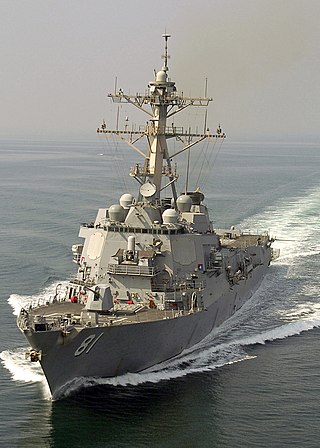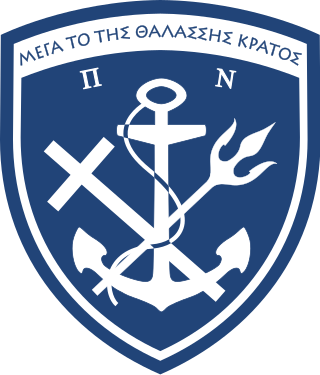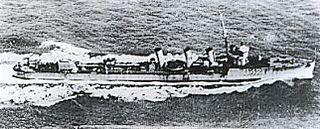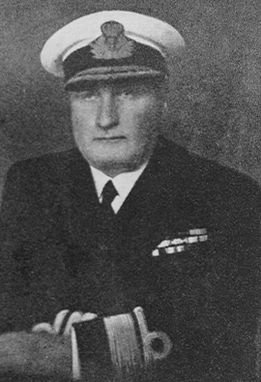
In naval terminology, a destroyer is a fast, maneuverable, long-endurance warship intended to escort larger vessels in a fleet, convoy, or battle group and defend them against powerful short-range attackers. They were originally developed in 1885 by Fernando Villaamil for the Spanish Navy as a defense against torpedo boats, and by the time of the Russo-Japanese War in 1904, these "torpedo boat destroyers" (TBDs) were "large, swift, and powerfully armed torpedo boats designed to destroy other torpedo boats". Although the term "destroyer" had been used interchangeably with "TBD" and "torpedo boat destroyer" by navies since 1892, the term "torpedo boat destroyer" had been generally shortened to simply "destroyer" by nearly all navies by the First World War.

The Hellenic Navy is the naval force of Greece, part of the Hellenic Armed Forces. The modern Greek navy historically hails from the naval forces of various Aegean Islands, which fought in the Greek War of Independence. During the periods of monarchy it was known as the Royal Hellenic Navy.

The Charles F. Adams class is a ship class of 29 guided-missile destroyers (DDG) built between 1958 and 1967. Twenty-three were built for the United States Navy, three for the Royal Australian Navy, and three for the West German Bundesmarine. The design of these ships was based on that of Forrest Sherman-class destroyers, but the Charles F. Adams class were the first class designed to serve as guided-missile destroyers. 19 feet (5.8 m) of length was added to the center of the design of the Forrest Sherman class to carry the ASROC launcher. The Charles F. Adams-class were the last steam turbine-powered destroyers built for the U.S. Navy. Starting with the succeeding Spruance-class, all U.S. Navy destroyers have been powered by gas turbines. Some of the U.S. Charles F. Adams class served during the blockade of Cuba in 1962 and during the Vietnam War; those of the Royal Australian Navy served during the Vietnam War and Gulf War.

The Flower-class corvette was a British class of 294 corvettes used during World War II by the Allied navies particularly as anti-submarine convoy escorts in the Battle of the Atlantic. Royal Navy ships of this class were named after flowers.
The History of the Hellenic Navy begins with the birth of modern Greece, and due to the maritime nature of the country, this force has been the premier service of the Greek Armed Forces.

The M class, more properly known as the Admiralty M class, were a class of 85 destroyers built for the Royal Navy of United Kingdom that saw service during World War I. All ships were built to an identical – Admiralty – design, hence the class name. 18 other vessels which were officially included within the 'M' class were built to variant designs by three specialist builders – 10 by Yarrow, 6 by Thornycroft, and 2 by Hawthorn Leslie; these are covered in other articles.

Adrias was a Type III Hunt-class destroyer that was originally built for the Royal Navy as HMS Border but never commissioned. Before her completion, she was loaned to the Royal Hellenic Navy on 20 July 1942 and commissioned as Adrias on 5 August 1942 in order to relieve heavy losses of ships sustained by the Royal Hellenic Navy during the German invasion of 1941 and throughout the war. Adrias took her name from the ancient Greek town of Adria in Italy, at the mouth of the Po river, after which the Adriatic Sea is named.

Nafkratousa was a Thyella class destroyer that served in the Royal Hellenic Navy (1906-1921).

Sfendoni was a Thyella class destroyer that served in the Royal Hellenic Navy (1907-1945). It was the second ship of that name in the Hellenic Navy, but the first destroyer-type vessel bearing the name.

Thyella was a Thyella class destroyer that served in the Royal Hellenic Navy (1907-1941). It was the first ship of that name in the Hellenic Navy.

Lonchi was a Thyella class destroyer that served in the Royal Hellenic Navy beginning in 1907. The ship, along with her three sister ships, was ordered from England in 1906 and was built in the Yarrow shipyard at Cubitt Town, London. Lonchi was 220 feet (67 m), displaced 352 metric tons, and was armed with two 18 in (46 cm) torpedo tubes, two 76 mm (3.0 in) guns, and two 57 mm (2.2 in) guns.

The Osprey 55-class gunboat is a Danish-designed class of naval ship currently in service in the Hellenic Navy and Royal Moroccan Navy. Two ships were ordered by Greece in March 1988 and built by Hellenic Shipyards. The first one was laid down on 8 May 1989 and launched on 19 December 1989. The second ship was laid down on 9 November 1989 and launched on 16 May 1990. Armament is of modular design and therefore can be changed. 76-millimetre (3 in) guns replaced the Bofors 40 mm (1.6 in) guns in 1995, after being taken from decommissioned Gearing-class destroyers. Options on more of the class were shelved in favour of the slightly larger HSY-55 class.

Leon was an Aetos-class destroyer which served in the Royal Hellenic Navy from 1912–1941.

Vasilefs Georgios was the lead ship of her class of two destroyers built for the Royal Hellenic Navy before the Second World War. Flagship of the navy's Destroyer Flotilla, she participated in the Greco-Italian War in 1940–1941, escorting convoys and unsuccessfully attacking Italian shipping in the Adriatic Sea. While under repair during the Axis invasion of Greece in 1941, Vasilefs Georgios sank when the floating drydock that she was in was either scuttled or sunk by German aircraft.

The Aetos class were four destroyers were originally constructed for the Argentine Navy as the San Luis class. In Greek they are known as the Thiria class, after the ships' names. They were purchased by the Royal Hellenic Navy in October 1912 when the Greek government expanded its navy after losing the Greco-Turkish War of 1897 and in anticipation of the Balkan Wars. In December 1916, during World War I, three of the destroyers were seized by France and served in the French Navy until 1918, all except Panthir. They were returned to Greece in 1918. In 1924–1925, they were extensively rebuilt and continued in service into World War II, where they fought with the Allies. Leon was sunk by German aircraft at Suda Bay, Crete. The other three destroyers survived the war and were used as station ships during the Greek Civil War. They were discarded in 1946.
The Niki class of destroyers were ordered by the Royal Hellenic Navy before World War I when the Greek government embarked on a naval buildup after losing the Greco-Turkish War of 1897. These four ships were ordered from Germany in 1905 and were built in the Vulcan shipyard at Stettin.

Nea Genea was a destroyer that served in the Royal Hellenic Navy from 1912–1919. She was originally the German destroyer V-6.
Keravnos was a destroyer that served in the Royal Hellenic Navy from 1912 to 1919. She was originally the German destroyer V-5.

Epameinondas Kavvadias was a Greek admiral who served thrice as Chief of the Navy General Staff and led the Greek fleet in the first years of World War II.
Pyrros Lappas was a Greek Navy officer. He served in the Asia Minor Campaign, commanded warships in World War II, and assumed senior leadership positions in the post-war navy, culminating as Chief of the Hellenic Navy General Staff in 1952–1958. He then served for two years as head of the Military Household of King Paul of Greece, as General Secretary of the Hellenic Olympic Committee in 1961–1968, and as a member of the International Olympic Committee (1965–1980).
















